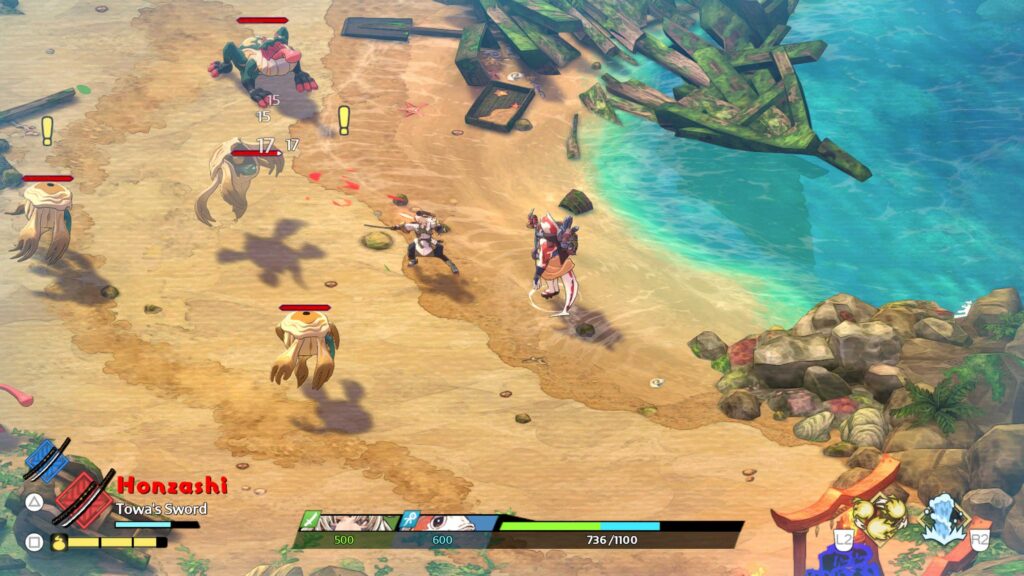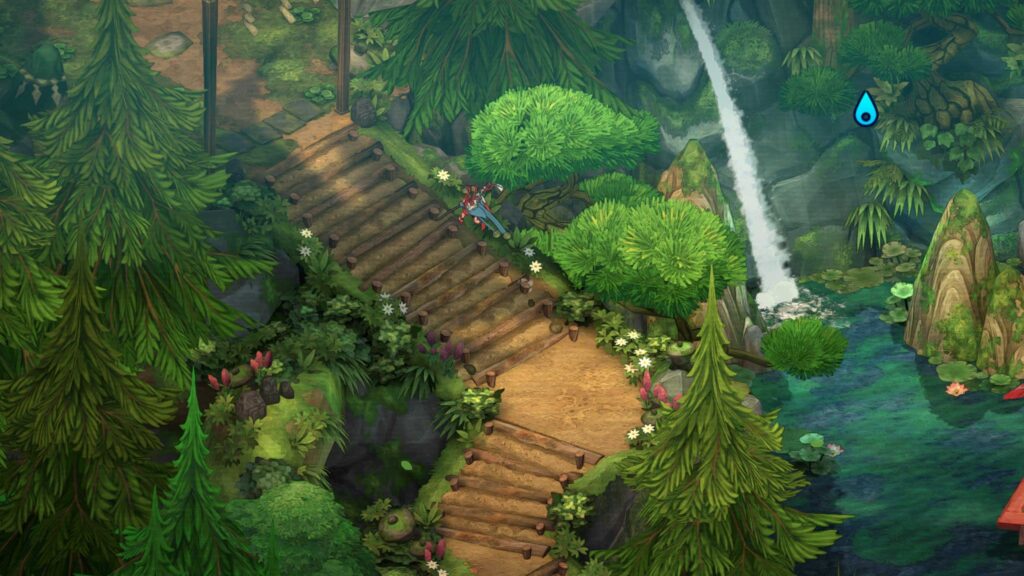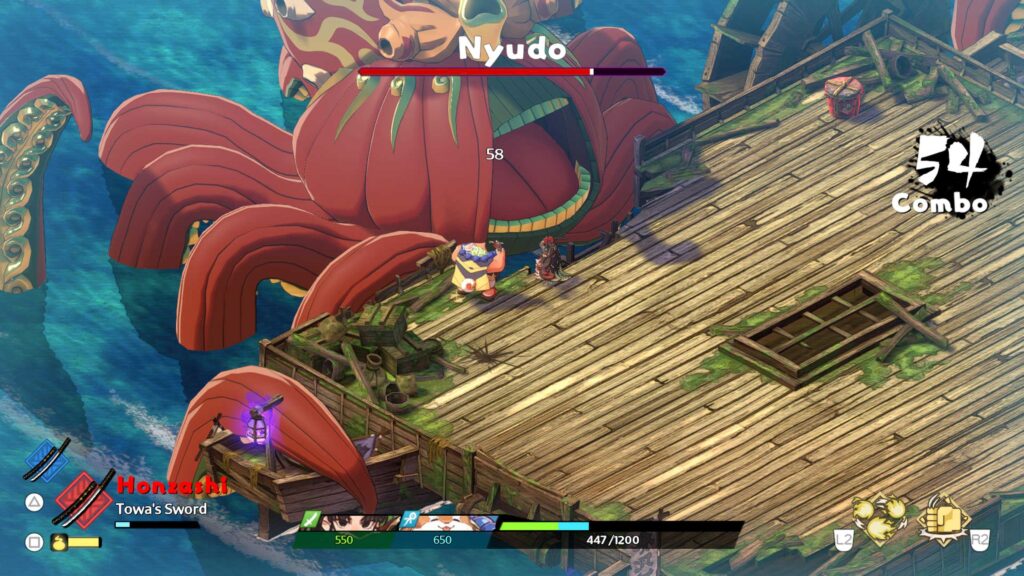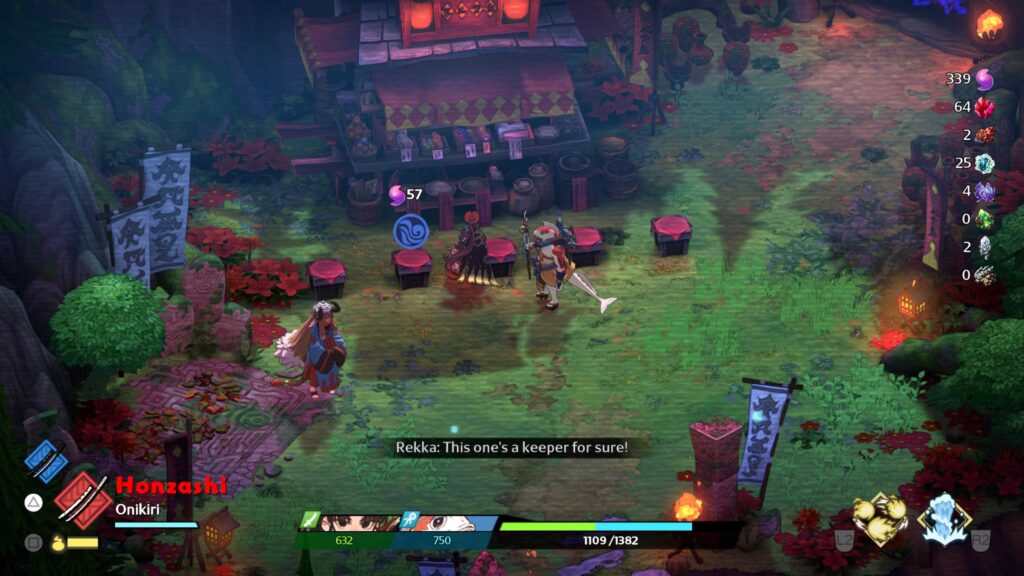If there is one positive thing that can be said about Towa and the Guardians of the Sacred Tree, there are genuine glimpses of a game with an engaging hook buried in there. A game that doesn’t follow the trends set forth by other games in the roguelike genre and forges its own path. Unfortunately, that really is the nicest thing that can be said, and it becomes worse when, to see those moments of promise, you have to wade through one of the most frustratingly annoying loops. Then you need to reckon with the fact that the loop is the game, and these moments feel more like a fluke of competency, hindered by a game that is hard to find pleasure in, and trust me, I take no pleasure in saying that.
Towa and the Guardians of the Sacred Tree is a rather generic anime-inspired game, which lets down an exciting art style shown early on, only to be replaced with a style you had probably come to expect. Towa and her compatriots are centered around a small village and travel off to fight enemies known as Magatsu. To do so, they travel into a roguelike structured zone where they fight monsters and earn and upgrade their gear before moving on. The twist to the typical formula is that while you play as Towa in the village, the eight guardians can be sent into the dungeons two at a time, with the player linking both or controlling them independently. A second player can also play as one of the characters, adding a multiplayer aspect that is pretty decent and offers one of the distinctions that help distinguish the game in at least one way from many of its peers.

There is a story connecting all of the events, but it is dulled out in some interesting ways as well. While you can expect to hit checkmarks from completing major enemies, these offering narrative events, much of the narrative plays out in the background. Two characters that travel through the many areas of combat can reach points where they can have a dialog, some offering nothing more than a goofy exchange, but others giving some much-needed background to the large cast of characters, and there are a lot of dialogs between each of the characters to enjoy, though if you get stuck looping annoyingly through it with the same two you can find they run out of things to say in three or four of the loops.
Combat itself plays out with characters being put into two positions: one that acts as an attacker, and one that acts as a spellcaster, with some distinction between characters in these roles, though not enough to make the choice feel impactful. Combat is that of an isometric hack and slash, but I cannot stress how baffling some of the decisions here are. For starters, you have two blades that are capped with durability, one a slash, while the other is a charged ability of some kind. These are not on two buttons; they need to be switched between with the often unresponsive quick slash ability that can also throw your character into enemy attacks for no reason. Enemies are also the kind that use indicators on the ground to depict their attack, but the game can throw so many enemies at you that the ground can be just plastered in red. Attacks can often have trouble actually going after the enemies you are trying to target, with many attacks just feeling unimpactful or hard to find the viability of, adding to the chaos.
Traversing through the dungeon, you reach doors that dictate what lies beyond that room, and in fairness, these abilities can be good, such as adding scorch to a primary attack or windwill to your charge. What becomes annoying, though, is just how unpredictable these can be. Healing, especially in the long run, is not just something you want; it is needed. However, I had many a run where I never once got a healing room to upgrade health, fix wounds, or gain an ability to actually heal. Beans can be found in pots that heal you, but in runs like the aforementioned one, I would not even find them, even with upgrades to their drop rate.

The characters have two life bars, and if one character goes down, you can still use them, just with massive nerfs that make winning fights, especially against bosses, nightmarish, less because the boss is hard and more because you are now doing even less to enemies with high health. The game has a massive imbalance issue with upgrading shields or health never outpacing the game’s increasing damage from bosses. Unlike most roguelikes that feature one path that you continually tackle, Towa and the Guardians of the Sacred Tree features multiple, progressively longer, roguelike dungeons you need to tackle. It reminded me of the way Dreamcast Title Evolution structured its world. The point of this is that by dungeon three, you are running hour-long sessions to try to defeat a boss that you can be instantly killed from full health at the finish line just by not reacting to one attack that just bleeds into a soul-crushing amount of drain that makes your hour wasted in a second. The number of times I watched my characters drop dead from an almost full bar right from a boss with no health in their bar is staggeringly high.
Even with the many tools the game gives to supplement this, it never seemed to offer a meaningful distinction to this problem. This leads to quite possibly the worst mini-game ever played through, the sword forge, which isn’t fun, but also necessary to gain new swords to increase your damage, a more noticeable way to increase your stats. The sword forge is a multistep process with moments you need to try to hit R1 in time with the gauge, or memorize where numbers were on a grid and hit them in order. This can take up to ten minutes to do, though 5 or 6 once you have the hang of what is going on. This then increases the durability of the blade based on how well you do, a stat you need to trade heavily to increase damage. This does become pronounced later on, but that is long past the point where the game goes from unenjoyable to frustratingly annoying. To get high damage, you basically need to make a weapon that gets three hits before you need to switch. Other mini-games are less obnoxious, but none managed to overcome the annoyance I was already feeling by the time I unlocked them.

One of the few bright spots, I will say, is the level design, which has multiple stages and area designs, with the game having a pretty diverse amount of biomes. These biomes also don’t overlap much, with a similar level design just in a cave. No, they feel unique, which is great. These levels are also big with waves of enemies, feeling organic in how they spawn. One stage on a bridge features enemies spawning at the start of the bridge, then once beaten, the next wave is in the center, before another spawns on the other side. It can be frustrating in its pace, but the stage is well utilized. Unfortunately, the music that goes along with all this often feels at odds. It reminded me of the tranquil field music as you explore an open area in a Final Fantasy game, but never shifts for any of the combat, which genuinely makes the whole experience feel contradictory to itself.
Each area caps off with mini-boss fights, leading to a final area with a main boss. For their part, some of the mini-bosses could be fun, such as the octopus that I fought on a boat early on, but many others just feel like standard enemies that take 10 minutes to kill and have obnoxious gimmicks. A moth, for instance, can put out pollen that surrounds them, and you might think you want to attack, but go inside the pollen and you can die by a random explosion that comes out of nowhere. If you didn’t pick a long-range character, this doesn’t make the enemy harder, just more annoying to get to and actually deal damage. Main bosses take that to extremes, feeling insanely easy right up until they start overlapping every single move they have over each other, so a wrong dash can instantly eliminate you. They do a great job of encouraging you to put the game down and switch to anything else.

Verdict
It’s not like the intention was to come into Towa and the Guardians of the Sacred Tree and hate it. These are the type of games I love, with Yasha: Legends of the Demon Blade being one I praised earlier this year, despite the flaws that it had. Here, though, there are bafflingly bad choices that play pivotal roles in the game, and it is really hard to get past that. Combat, especially the constant switching between blades, creates massive pacing issues in fights, not to mention making the company frustrating rather than fun. Then you have the sword crafting mechanic that might be ok if it were optional, but it isn’t. It wouldn’t be good if not forced on you, make no mistake, but it would be ok in that I could ignore it. This is compounded by the fact that all that time has very little payout to make the annoyance worth it. At the end of the day, I love roguelikes; it’s a genre I just can’t get enough of. I am hard-pressed to look through my library and find a title I would rank below Towa and the Guardians of the Sacred Tree.
Remember to follow us on Twitter, Facebook, and Bluesky to keep up to date on everything we have going on!
Reviewed for PlayStation 5, also available on Xbox Series, Nintendo Switch, and PC
Developer: Brownies Inc
Publishers: Bandai Namco
Release Date: September 19, 2025
Good:
+Level design
+some narrative elements
+multiplayer
Bad:
-Lackluster combat
-Mostly boring and frustrating boss design
-One of the worst mini-games that is forced onto players
-an interesting art style replaced with a more generic one early on
-
Towa and the Guardians of the Sacred Tree